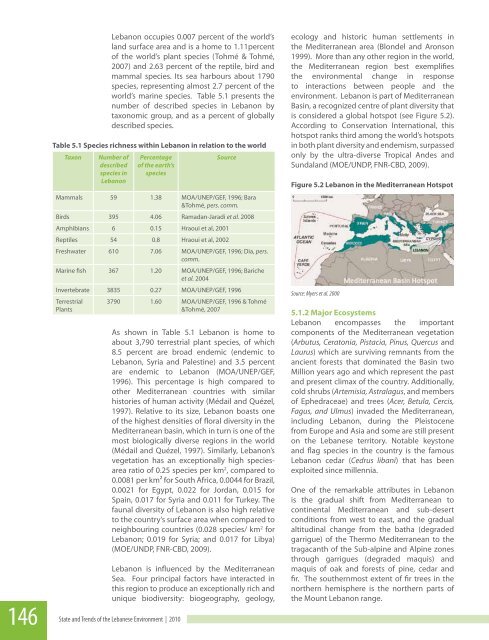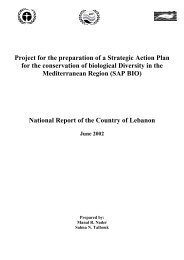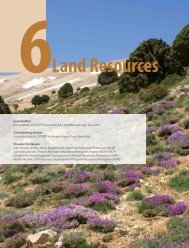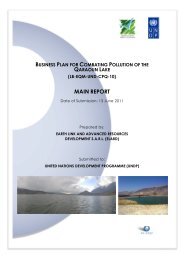Biodiversity and Forests
Biodiversity and Forests
Biodiversity and Forests
You also want an ePaper? Increase the reach of your titles
YUMPU automatically turns print PDFs into web optimized ePapers that Google loves.
146<br />
Lebanon occupies 0.007 percent of the world’s<br />
l<strong>and</strong> surface area <strong>and</strong> is a home to 1.11percent<br />
of the world’s plant species (Tohmé & Tohmé,<br />
2007) <strong>and</strong> 2.63 percent of the reptile, bird <strong>and</strong><br />
mammal species. Its sea harbours about 1790<br />
species, representing almost 2.7 percent of the<br />
world’s marine species. Table 5.1 presents the<br />
number of described species in Lebanon by<br />
taxonomic group, <strong>and</strong> as a percent of globally<br />
described species.<br />
Table 5.1 Species richness within Lebanon in relation to the world<br />
Taxon Number of Percentage<br />
Source<br />
described of the earth’s<br />
species in<br />
Lebanon<br />
species<br />
Mammals 59 1.38 MOA/UNEP/GEF, 1996; Bara<br />
&Tohmé, pers. comm.<br />
Birds 395 4.06 Ramadan-Jaradi et al. 2008<br />
Amphibians 6 0.15 Hraoui et al, 2001<br />
Reptiles 54 0.8 Hraoui et al, 2002<br />
Freshwater 610 7.06 MOA/UNEP/GEF, 1996; Dia, pers.<br />
comm.<br />
Marine fish 367 1.20 MOA/UNEP/GEF, 1996; Bariche<br />
et al. 2004<br />
Invertebrate 3835 0.27 MOA/UNEP/GEF, 1996<br />
Terrestrial<br />
Plants<br />
3790 1.60 MOA/UNEP/GEF, 1996 & Tohmé<br />
&Tohmé, 2007<br />
As shown in Table 5.1 Lebanon is home to<br />
about 3,790 terrestrial plant species, of which<br />
8.5 percent are broad endemic (endemic to<br />
Lebanon, Syria <strong>and</strong> Palestine) <strong>and</strong> 3.5 percent<br />
are endemic to Lebanon (MOA/UNEP/GEF,<br />
1996). This percentage is high compared to<br />
other Mediterranean countries with similar<br />
histories of human activity (Médail <strong>and</strong> Quézel,<br />
1997). Relative to its size, Lebanon boasts one<br />
of the highest densities of floral diversity in the<br />
Mediterranean basin, which in turn is one of the<br />
most biologically diverse regions in the world<br />
(Médail <strong>and</strong> Quézel, 1997). Similarly, Lebanon’s<br />
vegetation has an exceptionally high speciesarea<br />
ratio of 0.25 species per km 2 , compared to<br />
0.0081 per km² for South Africa, 0.0044 for Brazil,<br />
0.0021 for Egypt, 0.022 for Jordan, 0.015 for<br />
Spain, 0.017 for Syria <strong>and</strong> 0.011 for Turkey. The<br />
faunal diversity of Lebanon is also high relative<br />
to the country’s surface area when compared to<br />
neighbouring countries (0.028 species/ km 2 for<br />
Lebanon; 0.019 for Syria; <strong>and</strong> 0.017 for Libya)<br />
(MOE/UNDP, FNR-CBD, 2009).<br />
Lebanon is influenced by the Mediterranean<br />
Sea. Four principal factors have interacted in<br />
this region to produce an exceptionally rich <strong>and</strong><br />
unique biodiversity: biogeography, geology,<br />
State <strong>and</strong> Trends of the Lebanese Environment | 2010<br />
ecology <strong>and</strong> historic human settlements in<br />
the Mediterranean area (Blondel <strong>and</strong> Aronson<br />
1999). More than any other region in the world,<br />
the Mediterranean region best exemplifies<br />
the environmental change in response<br />
to interactions between people <strong>and</strong> the<br />
environment. Lebanon is part of Mediterranean<br />
Basin, a recognized centre of plant diversity that<br />
is considered a global hotspot (see Figure 5.2).<br />
According to Conservation International, this<br />
hotspot ranks third among the world’s hotspots<br />
in both plant diversity <strong>and</strong> endemism, surpassed<br />
only by the ultra-diverse Tropical Andes <strong>and</strong><br />
Sundal<strong>and</strong> (MOE/UNDP, FNR-CBD, 2009).<br />
Figure 5.2 Lebanon in the Mediterranean Hotspot<br />
Source: Myers et al. 2000<br />
5.1.2 Major Ecosystems<br />
Lebanon encompasses the important<br />
components of the Mediterranean vegetation<br />
(Arbutus, Ceratonia, Pistacia, Pinus, Quercus <strong>and</strong><br />
Laurus) which are surviving remnants from the<br />
ancient forests that dominated the Basin two<br />
Million years ago <strong>and</strong> which represent the past<br />
<strong>and</strong> present climax of the country. Additionally,<br />
cold shrubs (Artemisia, Astralagus, <strong>and</strong> members<br />
of Ephedraceae) <strong>and</strong> trees (Acer, Betula, Cercis,<br />
Fagus, <strong>and</strong> Ulmus) invaded the Mediterranean,<br />
including Lebanon, during the Pleistocene<br />
from Europe <strong>and</strong> Asia <strong>and</strong> some are still present<br />
on the Lebanese territory. Notable keystone<br />
<strong>and</strong> flag species in the country is the famous<br />
Lebanon cedar (Cedrus libani) that has been<br />
exploited since millennia.<br />
One of the remarkable attributes in Lebanon<br />
is the gradual shift from Mediterranean to<br />
continental Mediterranean <strong>and</strong> sub-desert<br />
conditions from west to east, <strong>and</strong> the gradual<br />
altitudinal change from the batha (degraded<br />
garrigue) of the Thermo Mediterranean to the<br />
tragacanth of the Sub-alpine <strong>and</strong> Alpine zones<br />
through garrigues (degraded maquis) <strong>and</strong><br />
maquis of oak <strong>and</strong> forests of pine, cedar <strong>and</strong><br />
fir. The southernmost extent of fir trees in the<br />
northern hemisphere is the northern parts of<br />
the Mount Lebanon range.





